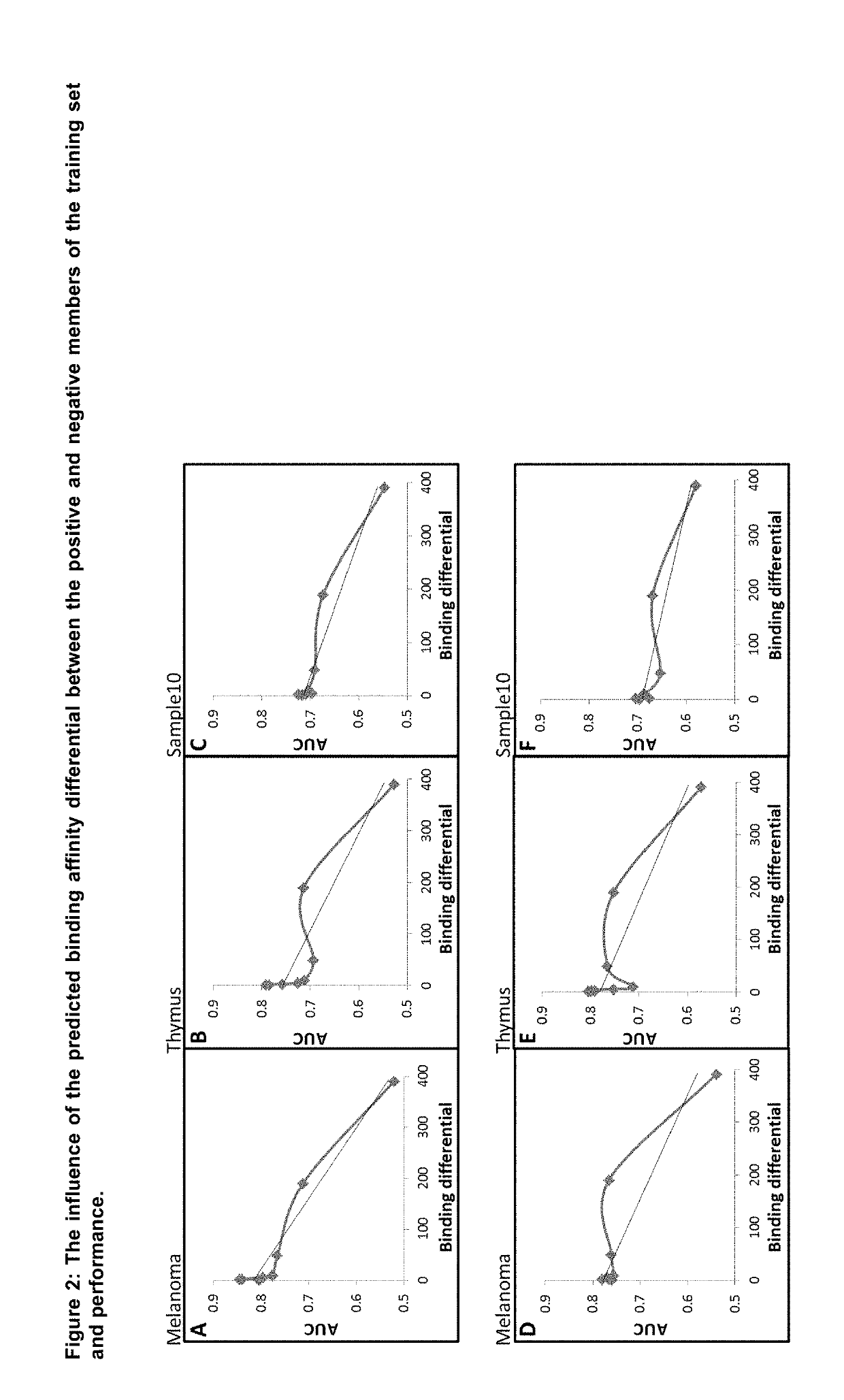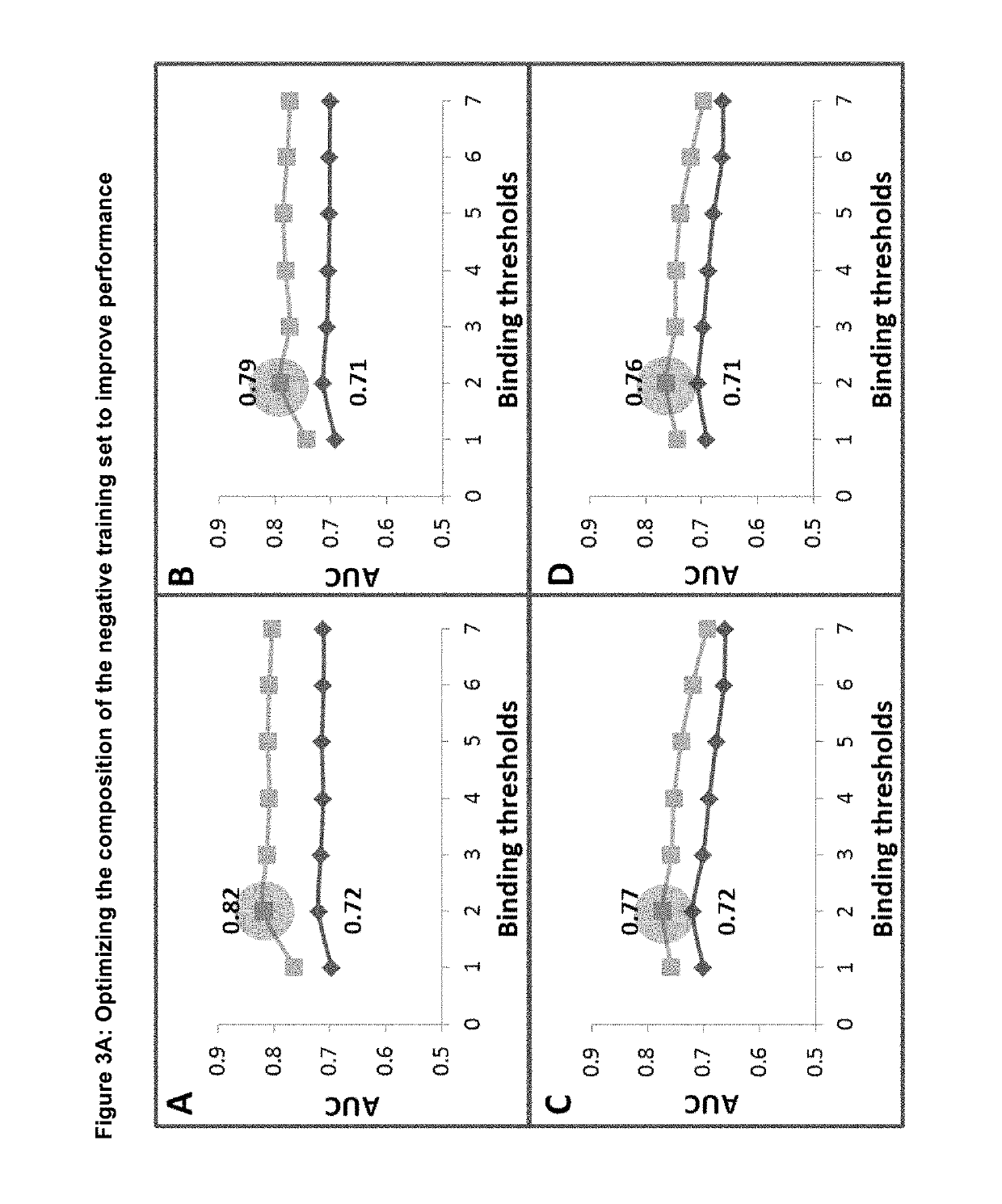Machine Learning Algorithm for Identifying Peptides that Contain Features Positively Associated with Natural Endogenous or Exogenous Cellular Processing, Transportation and Histocompatibility Complex (MHC) Presentation
a technology of peptides and features, applied in the field of machine learning algorithms, can solve the problems of not being particularly successful in identifying immunogenic epitopes, poor performance, and not very good at predicting mhc-i ligands identified from peptide elution studies, and achieve excellent processing features, improve training data, and reduce the risk of false negatives
- Summary
- Abstract
- Description
- Claims
- Application Information
AI Technical Summary
Benefits of technology
Problems solved by technology
Method used
Image
Examples
example 1
of Using Matched Pairs from Same Source Protein, and Subsequent Optimization of the Matched Pair Training Set
[0095]In order to investigate the benefit of selecting the matching negative from the same protein as the positive, different training sets were generated where the matching negative member of each pair was selected from the same or a random protein. The negative peptide was selected on the basis of it sharing a predicted binding affinity within a 10%, 100% or 10-100% range of its respective positive partner. The different training sets were then used to train a SVM algorithm, using VHSE and vector frequency (dimers) as training features across the whole peptide length and 3 amino-acid long peptide flanking regions extracted from the parental protein (subsequently referred to as the “Wide” configuration).
[0096]Each algorithm was then tested using three different independent test sets referred to as the Melanoma, Thymus & Sample10 test sets. The results for the different test ...
example 2
ting the Influence of the Predicted Binding Affinity Differential Between the Positive and Negative Members of the Training Set on Performance
[0098]In order to investigate the relationship between the positive and negative members of a matched pair used for training, different training sets were generated where the matching negative members were selected on the basis outlined in the table below; creating training sets with increasingly wide binding differentials between the positive and negative members.
TABLE 1Creating training sets with different binding differentialsAverageBindingTraining setNegative selection rangepredicted IC50differentialTraining set 1Between 0-10%451Training set 2Between 10%-100%772Training set 3Between 100-200%1213Training set 4Between 200-500%2425Training set 5Between 500-1000%45010Training set 6Between 1000-5000%2,16649Training set 7Between 5000-20000%8,393190Training set 8Worst match30,347391
[0099]Once the training sets were generated they were equalised i...
example 3
g the Composition of the Negative Training Set to Improve Performance
[0101]In order to find the optimal criteria for selecting the negative training set, we created a series of negative datasets where the negative peptide was selected on the basis of it sharing a predicted binding affinity within a pre-defined range of its respective matching positive partner as defined in table 2 below.
TABLE 2The different binding thresholds & criteria used to select the negative training setsThreshold ranges used to select the negative training datasetsSelection1234567criteria0-10%0-100%0-200%0-500%0-1000%0-5000%0-20000%ASelect the closest binder within the range - the negative can have a higher orlower binding affinity than its partnerBSelect the closest binder within the range - the negative must always have alower binding affinity than its positive partnerCSelect the furthest binder within the range - the negative can have a higheror lower binding affinity than its partnerDSelect the furthest b...
PUM
 Login to View More
Login to View More Abstract
Description
Claims
Application Information
 Login to View More
Login to View More - R&D
- Intellectual Property
- Life Sciences
- Materials
- Tech Scout
- Unparalleled Data Quality
- Higher Quality Content
- 60% Fewer Hallucinations
Browse by: Latest US Patents, China's latest patents, Technical Efficacy Thesaurus, Application Domain, Technology Topic, Popular Technical Reports.
© 2025 PatSnap. All rights reserved.Legal|Privacy policy|Modern Slavery Act Transparency Statement|Sitemap|About US| Contact US: help@patsnap.com



